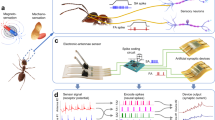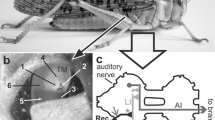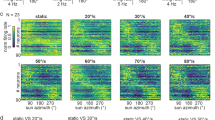Abstract
Antennal movement during tactile orientation behavior was examined three-dimensionally in American cockroaches during tethered walking. When a wooden rod was presented to the tip of one antenna in an upright orientation at one of the three different horizontal positions (30°, 60°, or 90° from the center of the head), the animal touched it repeatedly with the antenna, and tried to approach it (positive thigmotaxis). Positional shifts were also observed for the contralateral unstimulated antenna. The ipsilateral antenna tended to touch the object during inward movement (adduction) at all three test angles. The cumulative turn angle made during a continuous test period of 24 s clearly depended on the object’s position; however, the contact frequencies were almost the same regardless of the position. The relationships between contact frequency and some locomotion parameters were also investigated on a shorter time scale of 3 s. The contact frequency positively correlated with the turn angle, with the accuracy of orientation at all three test angles, and with the translation velocity at test angles of 30° and 60°. It is concluded that the performance during tactile orientation can be represented effectively by the frequency with which the antennae touch the attractive objects.









Similar content being viewed by others
References
Altner H, Prillinger L (1980) Ultrastructure of invertebrate chemo-, thermo, and hygroreceptors and its functional significance. Int Rev Cytol 67:69–139
Bell WJ (1991) Searching behaviour: the behavioural ecology of finding resources. Chapman and Hall, London
Chapman RF (1982) Chemoreception: the significance of receptor numbers. Adv Insect Physiol 16:247–356
Comer CM, Parks L, Halvorsen MB, Breese-Terteling A (2003) The antennal system and cockroach evasive behavior. II. Stimulus identification and localization are separable antennal functions. J Comp Physiol A 189:97–103
Dürr V, König Y, Kittmann R (2001) The antennal motor system of the stick insect Carausius morosus: anatomy and antennal movement pattern during walking. J Comp Physiol A 187:131–144
Erber J, Kierzek S, Sander E, Grandy K (1998) Tactile learning in the honeybee. J Comp Physiol A 183:737–744
Fanselow EE, Nicolelis MA (1999) Behavioral modulation of tactile responses in the rat somatosensory system. J Neurosci 19:7603–7616
Gentaz E, Hatwell Y (2003) Haptic processing of spatial and material object properties. In: Hatwell Y, Streri A, Gentaz E (eds) Touching for knowing: cognitive psychology of haptic manual perception. John Benjamins Publishing Company, Amsterdam, pp 123–159
Gibson JJ (1962) Observations on active touch. Psychol Rev 69:477–491
Hansen-Delkeskamp E (1992) Functional characterization of antennal contact chemoreceptors in the cockroach, Periplaneta americana: a electrophysiological investigation. J Insect Physiol 38:813–822
Hartmann MJ, Bower JM (2001) Tactile responses in the granule cell layer of cerebellar folium crus IIa of freely behaving rats. J Neurosci 21:3549–3563
Hollins M (2002) Touch and haptics. In: Yantis S (ed) Steven’s handbook of experimental psychology, vol 1. Wiley, New York, pp 585–618
Ikeda S, Toh Y, Okamura J, Okada J (2004) Intracellular responses of antennal chordotonal sensilla of the American cockroach. Zool Sci 21:375–383
Iwamura Y, Tanaka M (1978) Postcentral neurons in hand region of area 2: their possible role in the form discrimination of tactile objects. Brain Res 150:662–666
Katz D (1925) Der Aufbau der Tastwelt. Higashiyama A, Iwakiri K (trans) Shokkaku no sekai, Shinyosha, Tokyo (Japanese, 2003)
Keil TA, Steinbrecht RA (1984) Mechanosensitive and olfactory sensilla of insects. In: King RC, Akai H (eds) Insect ultrastructure, vol 2. Plenum Press, New York, pp 477–516
Kevan P, Lane MA (1985) Flower pedal microtexture is a tactile cue for bees. Proc Natl Acad Sci USA 82:4750–4752
Krause AF, Dürr V (2004) Tactile efficiency of insect antennae with two hinge joints. Biol Cybern 91:168–181
Lederman SJ, Klatzky RL (1987) Hand movements: a window into haptic object recognition. Cogn Psychol 19:342–368
Lederman SJ, Klatzky RL (1996) Action for perception: manual exploratory movements for haptically processing objects and their features. In: Wing AM, Haggard P, Flanagan JR (eds) Hand and brain: the neurophysiology and psychology of hand movements. Academic, New York, pp 431–446
Lederman SJ, Klatzky RL (1998) The hand as a perceptual system. In: Connolly KJ (ed) The psychobiology of the hand. Mac Keith Press, London, pp 16–35
Lee J-K, Strausfeld NJ (1990) Structure, distribution and number of surface sensilla and their receptor cells on the olfactory appendages of the male moth Manduca sexta. J Neurocytol 19:519–538
Levenberg K (1944) A method for the solution of certain problems in least squares. Q Appl Math 2:164–168
Marquardt D (1963) An algorithm for least-squares estimation of nonlinear parameters. SIAM J Appl Math 11:431–441
Martin H, Lindauer M (1966) Sinnesphysiologische Leistungen beim Wabenbau der Honigbiene. Z Vergl Physiol 53:372–404
Norris D, Chu H-M (1974) Morphology and ultrastructure of the antenna of male Periplaneta americana as related to chemoreception. Cell Tissue Res 150:1–9
Okada J, Toh Y (2000) The role of antennal hair plates in object-guided tactile orientation of the cockroach (Periplaneta americana). J Comp Physiol A 186:849–857
Okada J, Toh Y (2001) Peripheral representation of antennal orientation by the scapal hair plate of the cockroach Periplaneta americana. J Exp Biol 204:4301–4309
Okada J, Toh Y (2004) Spatio-temporal patterns of antennal movements in the searching cockroach. J Exp Biol 207:3693–3706
Okada J, Kanamaru Y, Toh Y (2002) Mechanosensory control of antennal movement by scapal hair plates in the American cockroach. Zool Sci 19:1201–1210
Pelletier Y, McLeod CD (1994) Obstacle perception by insect antennae during terrestrial locomotion. Physiol Entomol 19:360–362
Rüth E (1976) Elektrophysiologie der Sensilla Chaetica auf den Antennen von Periplaneta americana. J Comp Physiol A 105:55–64
Saager F, Gewecke M (1989) Antennal reflexes in the desert locust Schistocerca gregaria. J Exp Biol 147:519–532
Schafer R, Sanchez TV (1973) Antennal sensory system of the cockroach, Periplaneta americana: postembryonic development and morphology of the sense organs. J Comp Neurol 149:335–354
Schaller D (1978) Antennal sensory system of Periplaneta americana L.: distribution and frequency of morphologic types of sensilla and their sex-specific changes during postembryonic development. Cell Tissue Res 191:121–139
Scheiner R, Schnitt S, Erber J (2005) The functions of antennal mechanoreceptors and antennal joints in tactile discrimination of the honeybee (Apis mellifera L.). J Comp Physiol A 191:857–864
Schneider D (1964) Insect antennae. Ann Rev Entomol 8:103–122
Seelinger G, TobinTR (1981) Sense organs. In: Bell WJ, Adiyodi KG (eds) The american cockroach. Chapman & Hall, London, pp 217–245
Steinbrecht RA (1984) Chemo-, hygro-, and thermoreceptors. In: Bereiter-Hahn J, Matoltsy AG, Richards KS (eds) Biology of the integument, vol 1. Springer, Berlin Heidelberg New York, pp 523–553
Toh Y (1977) Fine structure of antennal sense organs of the male cockroach, Periplaneta americana. J Ultrastruct Res 60:373–394
Toh Y (1981) Fine structure of sense organs on the antennal pedicel and scape of the male cockroach, Periplaneta americana. J Ultrastruct Res 77:119–132
Zacharuk RY (1985) Antennae and sensilla. In: Kerkut GA, Gilbert LI (eds) Comprehensive insect physiology, biochemistry and pharmacology, vol 6. Pergamon Press, Oxford, pp 1–69
Zeil J, Sandeman R, Sandeman DC (1985) Tactile localization: the function of active antennal movements in the crayfish Cherax destructor. J Comp Physiol A 157:607–617
Acknowledgements
The authors are grateful to Dr. S. R. Shaw (Dalhousie University, Halifax, Canada) for reading the manuscript and giving valuable comments and to Mr. J. Wakamatsu for his helpful assistance. This study was supported in part by a Grant-in-Aid for Scientific Research on Priority Areas (A) from the MEXT (12048216), a Grant-in-Aid for Young Scientists from the JSPS (14740463), and the Narishige Zoological Science Award.
Author information
Authors and Affiliations
Corresponding author
Rights and permissions
About this article
Cite this article
Okada, J., Toh, Y. Active tactile sensing for localization of objects by the cockroach antenna. J Comp Physiol A 192, 715–726 (2006). https://doi.org/10.1007/s00359-006-0106-9
Received:
Revised:
Accepted:
Published:
Issue Date:
DOI: https://doi.org/10.1007/s00359-006-0106-9




